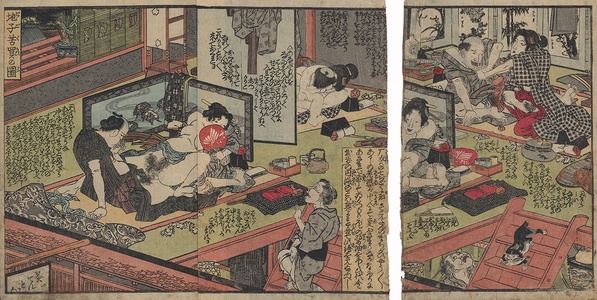| Method | Woodblock (nishiki-e) |
| Artist | Keisai Eisen (1790-1848) |
| Published | Tenpo 7 (1836) |
| Dimensions | Three Hanshibon sheets [each sheet ~222 x 155 mm] |
| Notes |
Series: Iro jiman edo murasaki: Tales of Sexual Conquest and the Violet of Edo A rare shikake-hon (trick moving picture) from Volume I Eisen's Iro jiman edo murasaki: Tales of Sexual Conquest and the Violet of Edo, a story about a man who loves women more than food. This print is set upstairs in a low class brothel where a man has sex with an older woman next to a screen with turtles painted on it. The woman lies back with her left arm resting on a takamakura (raised sleeping pillow),naked, her kimono draped over the screen. A red fan with a butterfly lies to her right. The man still wears his kimono and is pinching his nose with his left hand and lies back resting on his right hand. Used tissues and a part-open fan lie next to them. Behind them is another couple, the woman clutching at a man's kimono. In the background are a tea pot, sake, and food, as well as a screen with panels each depicting iris, chrysanthemum, bamboo, and a plum tree. A cat holding a fish in its mouth runs down the stairs as an old woman peers up between the stairs and the upstairs floor. When the page is opened the old woman has seen what is happening and is laughing at the first couple, the reclining geisha holds the butterfly fan in front of her face, the couple in the background have put up the screen, the man's kimono is draped over it, and he and the geisha lie locked in an embrace amongst crumpled tissues and takamakura. Shunga is the term used for the body of erotic imagery produced in Japan from 1600 to 1900. The term shunga means spring pictures, a euphemism for sex, and is one of several names for erotic material produced in Japan. Shunga took different formats: painted hand scrolls, painted books, printed books and albums, and sets of prints which were sometimes sold in wrappers. As prints they are one of the genres of ukiyo-e, or Floating World prints, which also include fukeiga (landscape prints), and bijin-ga (prints of beautiful women). Most of the major ukiyo-e artists produced shunga material at some point during their careers, including Utamaro (who produced more erotic books than non-erotic books), Hokusai, and Hiroshige. Produced at the same time as the introduction of full colour woodblock printing, shunga prints and books were made using the most lavish and complicated printing techniques, including gauffrage, metallic inks, mica, complicated printed patterns, and multicolour printing using a high number of different colours. Although prolific in its number and variety, shunga should be seen as more representative of the ideals of the ukiyo, with its emphasis on mutual pleasure, rather than as an accurate representation of Japanese attitudes and practices of sexuality. Shunga present an invitation to pleasure through the bliss of lovemaking and though largely heteronormative, they portray the full gamut of couplings, married or otherwise, often surrounded by lavish settings and objects of pleasure. Keisai Eisen (1790-1848) was a ukiyo-e artist born in Hoshigaoka in Edo Japan. The son of the samurai, poet, and calligrapher Ikeda Masahei Shigeharu, Eisen studied painting in the Kanō style under Kanō Hakkeisai from whom he got the name Keisai. He then went on to train as a kabuki playwright. After the death of his father, he lodged with the family of Kikugawa Eizan. It was then that Eisen became interested in ukiyo-e and studied under Eiji, Eizan's father. It was also at this time that he became interested in the work of Hokusai who heavily influenced his style. Eisen specialised in bijin-ga (pictures of beautiful women), including his o-kubi-e (large head pictures) and full length portraits, also made landscapes and pictures of famous places contributing 24 designs to Kisokaidō rokujūkyū-tsugi: Sixty-nine Stations of the Kisokaidō Road, c. late 1830s) designed with Hiroshige. He designed many erotic prints and book illustration as well as compiling medical texts and sex manuals into the four volume (Keichu kibun) Makura bunko: Heard and Recorded in the Bedroom: Pillow Library. In addition to prints, painting, and book illustrations Eisen also wrote novels, plays, history books, legends and biographies notably the second edition of Ukiyo-e Ruiko (History of Prints of the Floating World) which contains the most comprehensive collection of biographies of ukiyo-e artists including himself in which he describes himself as a heavy drinker and claimed to have owned a brothel in Nazu in the 1830s. Ex. Col: Peter Darach Reference: Honolulu Museum of Art, Asian Art: Japanese Books and Manuscripts, Object number: 2016-56-041.01. Condition: Rubbing and soiling to lower left and right corners, creasing to centre of moving top sheet, right edge of the non-moving sheet has been trimmed. |
| Framing | unmounted |
| Price | £350.00 |
| Stock ID | 53173 |

